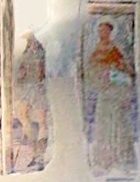

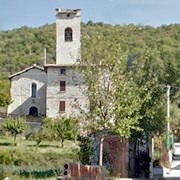
First Church (7th century)
In 1935, Enrico Stefani excavated a site known as le Cartiere (slightly to the south of the current church). He apparently found architectural fragments from what was probably the first church of San Facondino, together with evidence of a cemetery that had been use from the 7th century BC until the 6th century AD, along with. Excavations in 1990 found a further eleven Lombard tombs on a part of the site: grave goods (7th century AD) from a number of these tombs are exhibited in the Museo Civico.
This church was probably built to house the relics of St Facundinus. According to tradition, he was elected as bishop of Tadinum in 599 and died in 607. This church was destroyed in the tumultuous centuries that followed.
Present Church (11th Century)
The church on this site was possibly built by Rodolfo and Offredo, the sons of Monaldo III dei Conti di Nocera, who are also credited with the construction of the Abbazia di San Benedetto Vecchio. The presumed relics of St Facundinus and those of his deacon, St Juventinus, were duly translated here.
The church belonged to the episcopal authorities of Nocera, probably from the time of the formation of this diocese (at the expense, inter alia, of that of Tadinum) in 1007. It became the episcopal seat in the period 1248-55, when the Ghibellines drove Bishop Berardo Merganti from Nocera.
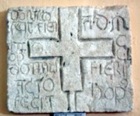
Cardinal Alessandro Oliva [with Cardinals Bessarion and Enea Silvio Piccolomini] stopped at San Facondino in 1461, during their journey to bring the skull of Saint Andrew the Apostle to Rome. Cardinal Oliva granted indulgences to the church during this stay.
When the high altar was restored in 1584, the relics of SS Facundinus and Juventinus were formally recognised and translated to this altar. They were exposed again in 1610 and placed so that they could be seen through a metal grating. Part of the relics were transferred to the Duomo of Nocera at that time. Another recognition was recorded in 1695.
The relics were removed from their wooden reliquary in 1907, on the 3rd centenary of the death of St Facundinus, and inserted into the chest of a statue of the saint that was enclosed in a glass sarcophagus on the high altar. When the relics of the Blessed Angelus (below) were placed in a new reliquary and translated to the chapel off the left wall of San Benedetto in 1961, the redundant reliquary (1888) was re-used for the relics of SS Facundinus and Juventinus.
Church
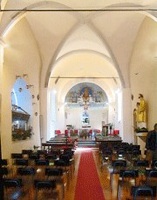
Three phases of construction can be identified in the church. The apse belongs to the most recent of these.
The campanile contains three bells, the oldest of which was dated 1255. This bell ruptured in the 18th century and was subsequently recast.
This website describes the restoration of the church after the earthquake of 1997.
SS Roch and Antony of Padua (15th century)
Relics of SS Facundinus and Juventinus

Present reliquary on the left wall of San Facondino
The history of these relics is quite complex.
A sarcophagus (ca. 7th century) from Santa Colomba, Rimini, which is now in the Cella delle Reliquie of the Tempio Malatestiano, is inscribed:
HEC SVNT NOMINA S[AN]C[T]ORV[M]:
FELICITAS PEREGRINVS FACCONDINVS IVVENTINVS
These are the names of the saints [contained in the sarcophagus]:
Felicita, Peregrine, Facundinus, Gioventinus
and below
HEGO NATALIS PECCATOR EP[ISCOPV]S ANC[ONAE] CORPORA S[AN]C[T]ORUM
This refers to an otherwise unknown Bishop Natale of Ancona
It is possible that this sarcophagus once contained (and perhaps still contains) relics of saints from Gualdo Tadino:
-
✴a church of Santa Felicita outside Gualdo Tadino was documented in the 13th century; and
-
✴the church and village of San Pellegrino, outside Gualdo Tadino, were also documented from about this time.
However, the presumed relics of St Facundinus and his deacon, St Juventinus have long been venerated in San Facondino. They were formally recognised in 1584 and translated to the new high altar of the church. They were exposed again in 1610 and placed so that they could be seen through a metal grating. Part of the relics were transferred to the Duomo of Nocera at that time. Another recognition was recorded in 1695.
The relics were removed from their wooden reliquary in 1907, on the 3rd centenary of the presumed date of death of St Facundinus, and inserted into the chest of a statue of the saint that was enclosed in a glass sarcophagus on the high altar. When the relics of the Blessed Angelus were placed in a new reliquary and translated to the chapel off the left wall of San Benedetto in 1961, the redundant reliquary (1888) was re-used for these relics of SS Facundinus and Juventinus. I presume that this reliquary, which is now on the left wall of the church, is that of 1888, and that the statue in it still contains the relics of SS Facundinus and Juventinus.
Art from the Church
Polyptych (15th century)
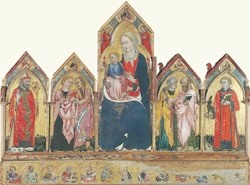
This polyptych from the high altar, which was selected for transfer to the civic collection in 1888, was probably actually transferred after its inclusion in an exhibition of 1907. It is now in the Pinacoteca Comunale.
The polyptych depicts:
-
✴the Madonna and Child enthroned with two angels, in the main panel;
-
✴two pairs of saints to the sides:
-
•SS John the Evangelist and John the Baptist, on the left; and
-
•SS Peter and Paul, on the right;
-
✴two saints at the extremes:
-
•St Facondinus, on the left; and
-
•St Laurence, on the right;
-
✴figures in tondi of the Christ and the Evangelists, in the trilobes above the panels; and
-
✴figures in tondi of the resurrected Christ and the Apostles, in the predella.
Other
A Romanesque pillar from San Facondino now serves as the altar of the Eremo di Serrasanta.
